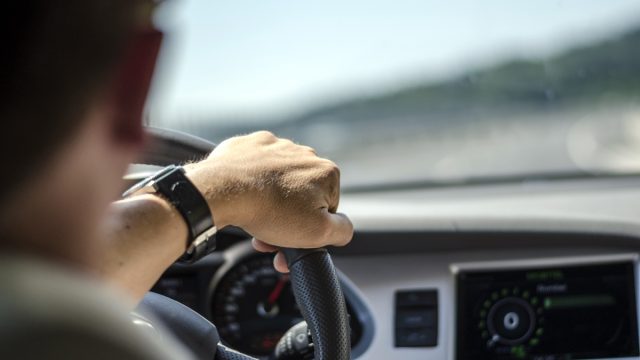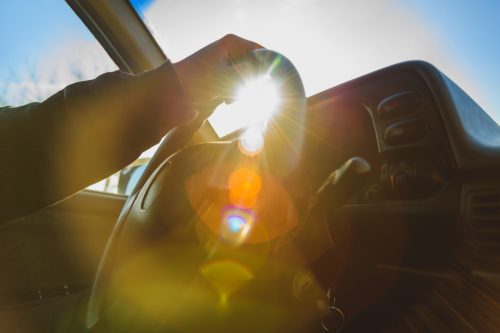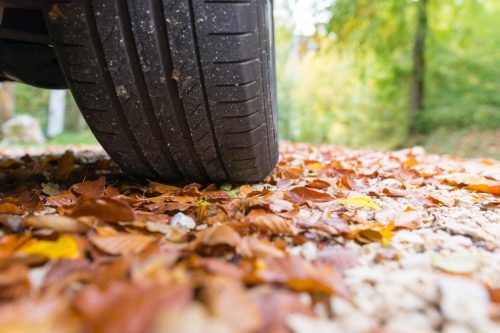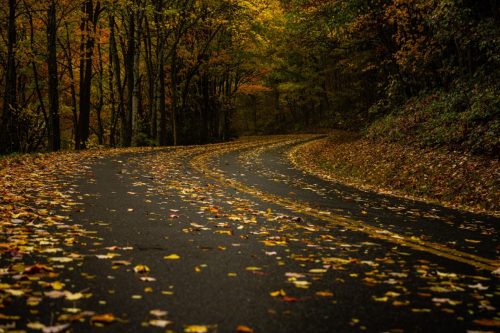If You See This While Driving, Slow Down Immediately, Police Say in New Warning

Getting behind the wheel of a car is a lofty responsibility, not to mention the trust you’re forced to place in your fellow drivers. Accidents do happen—according to data from the U.S. Department of Transportation (DOT), there were 35,766 fatal car crashes in 2020, resulting in approximately 38,824 deaths. With that in mind, police are charged with the task of keeping the roads safe, which includes officers asking that you obey the speed limit to help avoid a collision. But they’re now asking you to slow down even further if you see something on the road. Read on to find out when police say you need to ease up on the gas pedal.
READ THIS NEXT: If You See This While Driving, “Take an Alternate Route,” Police Say in New Warning.
Police have addressed hazards associated with the changing seasons.

Fall is in full swing, which means chillier temperatures and earlier sunsets. This can create hazards for drivers, in particular, as sun glare is more intense during the autumn months and can have a blinding effect. This glare is that much more intense in the morning and evenings, creating difficulties for commuters who have to get to and from work.
Police in Celina, Texas, recently issued a warning about sun glare, asking drivers to consider alternate routes to avoid bright sunlight. In an Oct. 18 Facebook post, drivers were also asked to keep a pair of sunglasses (preferably polarized) on hand and to make use of those nifty sun visors.
Not being able to see the road is certainly scary, but another seasonal hazard has prompted a new police warning.
Foliage is as dangerous as it is beautiful.

Foliage is one of the most anticipated aspects of fall, with many of us eagerly waiting to watch green leaves turn to shades of red, yellow, and orange. But after the colors change, the next stage in the lifecycle involves leaves falling off—and that’s exactly what police want you to be conscious of.
According to the National Highway Safety Administration (NHSA), the accumulation of leaves on roadways makes it harder for drivers to see pavement and obstacles like potholes. Certain traffic indications can also be hidden by leaves, including pavement markers indicating crosswalks and turning lanes. Making matters worse, when these leaves get wet, they create a slippery surface that’s comparable to driving on ice, per the NHSA. This is due to a “film of water” that covers the leaves, and unfortunately, your tires aren’t as adept at stopping in these conditions.
Now, Connecticut State Police (CSP) have issued a warning about these wet roads and what you need to do to keep yourself safe.
RELATED: For more up-to-date information, sign up for our daily newsletter.
Take certain precautions when driving.

If you find yourself driving on a road in these conditions, it’s vital that you slow down. “You’ll need much more time & space to brake,” the CPD said in an Oct. 24 Facebook post.
The NHSA also encourages this, reminding drivers that you need over double the normal stopping distance when driving on a wet, leaf-covered road. According to the administration, it takes 80 feet of roadway to stop when you’re going 45 miles per hour, but when a road is wet and covered with leaves, traveling at the same speed requires over 200 feet of stopping distance. As such, it’s important to leave additional space between yourself and the cars in front of you.
The CPD also recommends turning your headlights on to improve visibility and checking your tires, since those with “good tread” are better for channeling water away. Cleaning any leaves off of your car is recommended as well “so that they don’t create an obstruction for you or other drivers.”
Here’s what you should do if you do start to skid.

While you can take several preventive measures to keep yourself safe on the road this fall, skidding does happen. According to the NHSA, if you lose traction and start to swerve, it’s crucial to take your foot off of the gas and avoid the temptation to pump your brakes.
“Braking hard will only increase the slide,” officials said. “Point your wheels in the direction you want your vehicle to go. As your vehicle straightens out, you’ll need to adjust your steering again.”